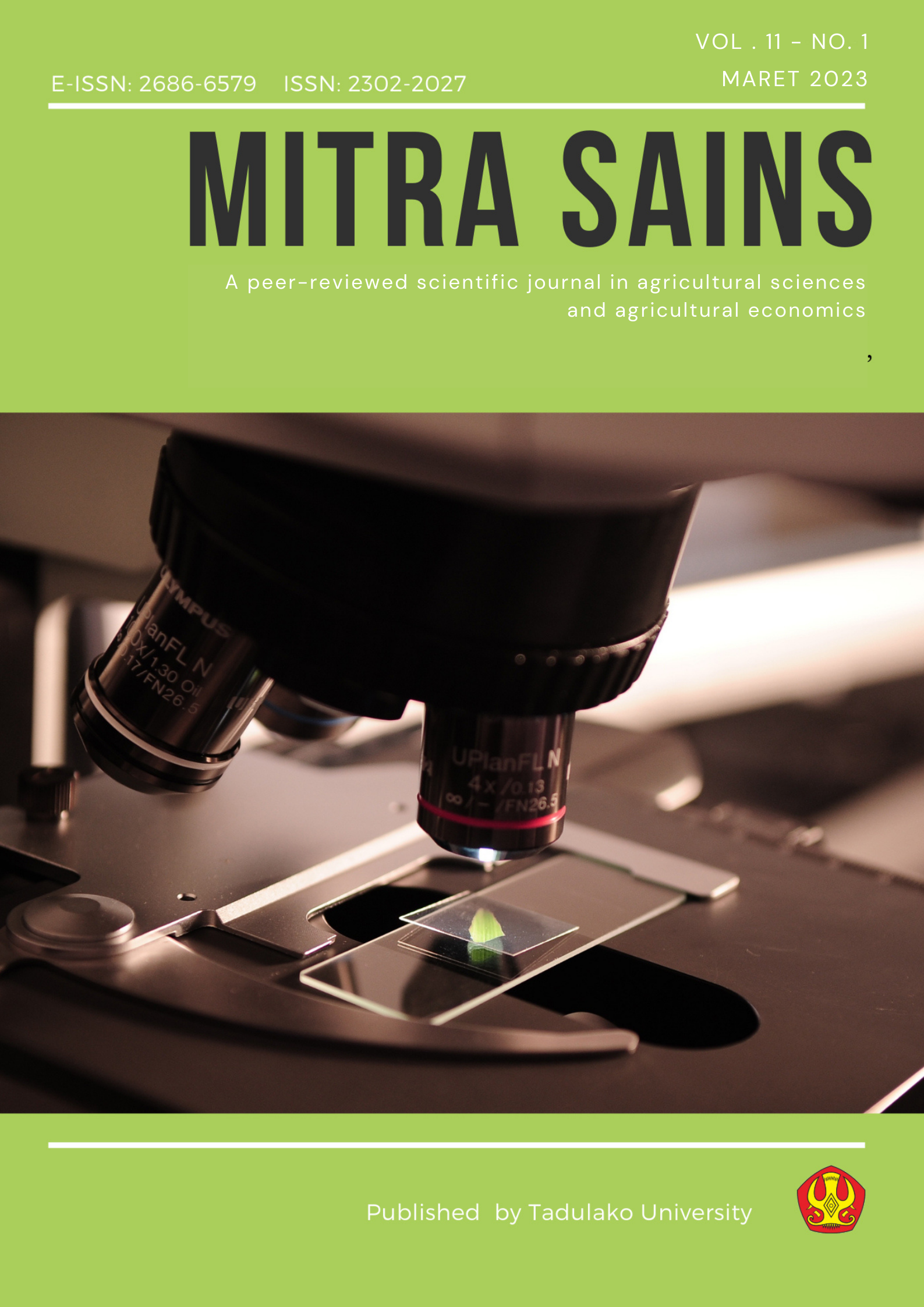Dynamics of Bali Cattle Population in The Northern of Parigi Moutong Regency
Abstract
This study aims to analyze the dynamics of the Bali cattle population in the northern part of Parigi Moutong Regency, this study has been carried out in three districts, namely Bolano, Bolano Lambunu and Moutong for two months, from March to May 2022. The method used in this study is a purposive method. sampling. The parameters observed in this study are the income rate consisting of the annual birth rate, the annual purchase rate, the annual cattle subsidy/assistance and the expenditure rate including the mortality rate (mortality), slaughter and sales as well as natural growth/Natural Increase (NI). The results showed that, the income rate for the birth rate to the mother was 54.03% and the birth rate to the population was 22.41% from 362 calves born, while the purchase rate was 6.32% from 102 heads and assistance was 6.13%. of 100 heads. The expenditure rate for the sales level is 7.18% of the 116 birds sold, while the slaughter rate is 2.48% from 40 birds, the mortality rate to the broodstock is 1.94% from 670 birds and the mortality rate to the population is 0.8% from 1615. cattle, so the number in the NI value is 21.61%.
References
Budiarto, A. L., Hakim., Suyadi, V. M., Nurgiartiningsih, A., & Ciptadi, G. (2013). natural increase sapi di wilayah instansi populasi dasar Provinsi Bali. Jurnal Ternak Tropikal, 14(2), 46-52.
Bawono, I. R. (2019). Optimalisasi potensi desa di Indonesia. Gramedia Widiasarana Indonesia.
Dinas Peternakan dan Kesehatan Hewan Kabupaten Parigi Moutong. (2020). Data Populasi ternak di Kabupaten Parigi. Parigi: Kementerian Pertanian.
Purwantara, B., Noor, R. R., Andersson, G., & Rodriguez-Martinez, H. (2012). Banteng and Bali cattle in Indonesia: Status and forecats. Reprod Dom Anim, 47(1), 2-6.
Putra, Y. E. (2017). Struktur dan Dinamika Populasi Ternak Sapi Potong di Kecamatan Payakumbuh Timur Kota Payakumbuh. Skripsi. Fakultas Peternakan Universitas Andalas. Payakumbuh.
Rusdiana, S., & Praharani, L. (2018). Pengembangan peternakan rakyat sapi potong: kebijakan swasembada daging sapi dan kelayakan usaha ternak. In Forum Penelitian Agro Ekonomi, 36(2), 97-116).
Sudrana, I. P., Lestari. R., Jan, T., Rozy., & Kasip, L. M. (2014). Estimasi kebutuhan dan supply calon bibit dan bibit untuk sapi bali di Kabupaten Lombok Barat. Jurnal Penelitian UNRAM, 18(1), 18-26.
Sugiyono. (2017). Metode Penelitian Kuantitatif, Kualitaif dan R&D. Bandung: Alfabeta.
Sugiyono. (2018). Metode Penelitian Kuantitatif, Kualitatig, dan R&D. Bandung: Alfabeta,
Sumadi., Hardjosubroto, W., Ngadiyono, N., & Prihadi, S. (2001). Potensi sapi potong di Kabupaten Sleman. Analisis dari segi pemuliaan dan produksi daging. Skripsi. Yogyakarta: Fakultas Peternakan Universitas Gadjah Mada.
Tatipikalawan, J. M., & Hehanussa, S. C. (2006). Estimasi natural increase kambing lokal di Pulau Kisar Kabupaten Maluku Tenggara Barat. Jurnal Agroforestri, 1(3), 83-91
Utami, E. U. (2015). Struktur Populasi sapi Bali di peternakan rakyat Kelurahan Sapaya Kabupaten Gowa. Skripsi tidak diterbitkan. Makassar: Fakultas Peternakan Universitas Hasanuddin
Wardhani, B., Faisal, M. D., & Paramita, T. D. (2018). Migrasi dan Transnasionalisme di Pasifik Selatan. Airlangga University Press.

Copyright (c) 2023 Indah Mayu Nita, Yohan Rusiyantono, Amiruddin Dg Malewa

This work is licensed under a Creative Commons Attribution-ShareAlike 4.0 International License.





